Main Menu
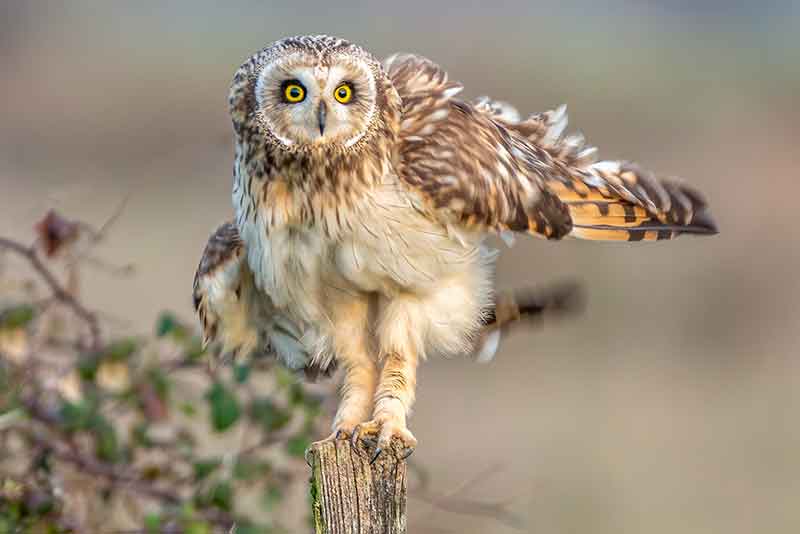
It’s International Owl Awareness Day today and we’re going to celebrate it by taking a close look at owls’ legs and feet.
Owl legs went viral on the internet a couple of years ago when pictures were shared on social media of owls with their legs exposed. For the non-ornithological among us (and possibly for some of the ornithological), the pictures caused quite a stir because people couldn’t believe how long their legs were.
To find out what’s going on we need to take a look at how owls have evolved. Plus, we have pictures if that’s what you’re after.
If you’ve ever seen an owl in flight, you’ll know that it travels almost silently, and that’s mainly down to its feathers.
An owl has thick, velvety feathers which absorb a lot of sound as it flies in a process known as damping. It also has relatively large wings in comparison to the size of its body so they can beat slowly making little noise as they flap. Finally, the primary flight feathers have stiff comb-like fringes on the edges which break up the air as it travels over them to minimise the ‘whoosh’ sound caused by turbulence.
It is thought silent flight gives an owl two main advantages. It can sneak up on its prey without being detected, and it also means it can hear prey without the noise from its own wing beats blocking out the sound. This is particularly important in a family of birds that tends to hunt at night or at dusk.
Fish and insect-eating owls have smaller combs on their wings and make more noise when they fly than owls that hunt mammals, which would seem to support the stealthy hunting theory.
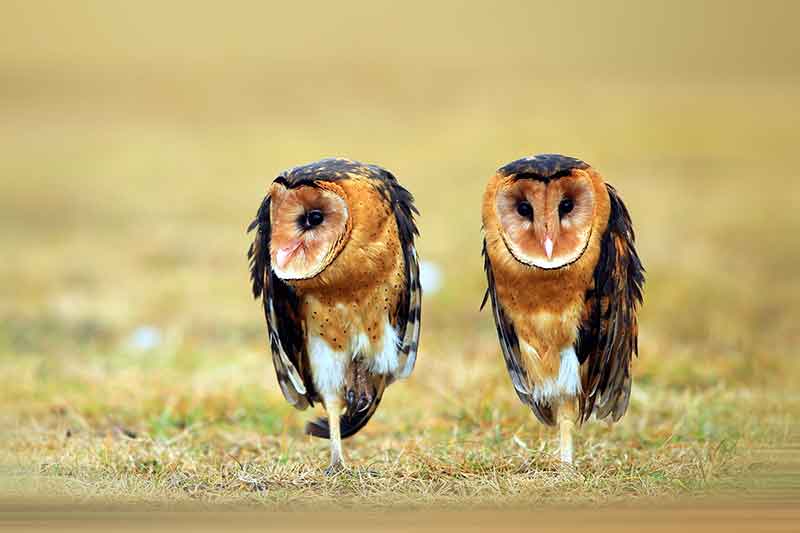
When an owl isn’t flying in search of prey it spends much of its time perched in a tree. Its feathers help it blend into its environment and you’ll notice that many owls are almost perfectly camouflaged.
For example, the snowy owl has white feathers that help it hide in its snowy habitat, owls that live in trees, such as the eastern screech owl, have grey or white feathers that can sometimes make them almost impossible to see, while grassland species, such as the African grass owl, have light brown feathers that match the dry grasses and brown earth of their surroundings.

Owls have other tricks to help keep themselves concealed. They stand up tall and pull their feathers tightly around them to disguise their shape and blend into their surroundings. Tufted owls raise their tufts to resemble twigs or small branches and round-headed owls lift their facial and eyebrow feathers.
When it’s perched, the thick feathers on an owl’s belly hang down covering the full length of its legs. Sometimes, in owls with shorter feathers such as the barn owl, you can see what looks like its knees that seem to bend backwards in the opposite direction to a human’s knees. But these aren’t its knees, which are much further up close to its body. What you’re looking at are its ankles – the owl is standing on its tiptoes which helps it to balance.
This confusion between ankle and knee together with an owl’s long body feathers is why until all was revealed on the internet, many people had no idea that owls had such long legs.
The length of the legs varies considerably between species. Some owl species have feathers on their legs and toes to protect them from the cold and to help them sense when they have made contact with prey, which can add to the illusion.
The barn owl, for example, has long legs that help it snatch prey from long grass, but they are sparsely feathered, despite the species inhabiting temperate areas, so that they don’t become sodden when hunting in damp grass. The grass owls that live in Africa, Asia, and Australia, hunt in areas with even taller vegetation and so their legs have evolved to be much longer.

The snowy owl and the eagle owl that live in cold regions have the thickest leg feathers of all whereas at the other end of the scale the fishing owls have completely bare legs to prevent their legs from becoming waterlogged when hunting.
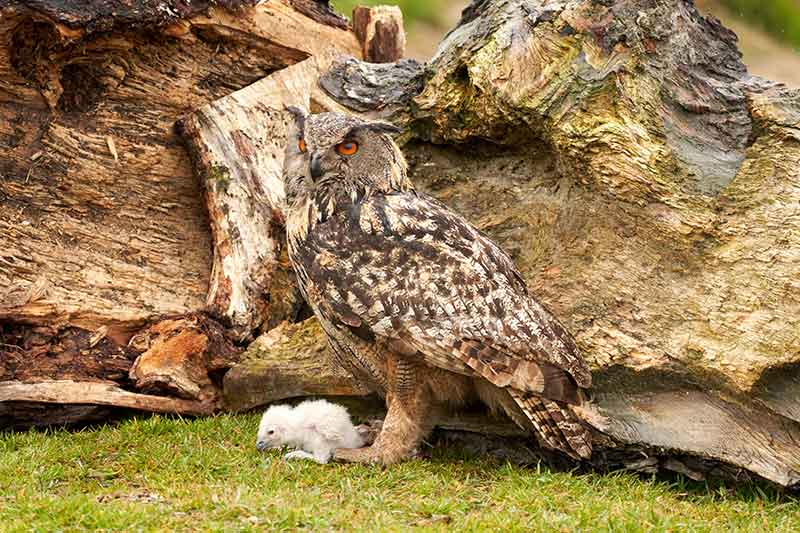
At the end of the long and surprisingly slender legs are four toes on each foot. Although owls are officially considered zygodactyl with two toes pointing forward and two pointing backward, the outer toe of each foot can swivel to face in either direction. At rest, it points roughly forward sticking slightly out to the side, but when the owl is perched on a branch or holding onto prey it faces backwards. Like other birds of prey, the owl locks a ratchet-like mechanism in its foot so it can grip without contracting its muscles.
When hunting, an owl’s outer toe points forward, known as anisodactyl, and it spreads its talons wide to increase the chance of a successful strike. The underside of the foot is rough and knobbly to help it get a good grip, and the bony structures in its feet are relatively short and strong to withstand the force of the impact with prey.
Most owls hunt from the air or a perch and it’s rare to see them run or walk on the ground. Walking exposes them to predators so if you spot an owl on the ground, it’s likely to be sick or injured and may need some help.
The most well-known exception is the burrowing owl, that lives on the prairies of North and South America. Because it lives in open grasslands and deserts instead of forests, it evolved much longer legs that enable it to run as well as fly when hunting. It eats insects and small rodents, sprinting after them on it long, powerful legs. The extra height also helps give it a better view of predators, such as badgers, foxes, raccoons, and skunks, who roam the plains looking for their next meal.
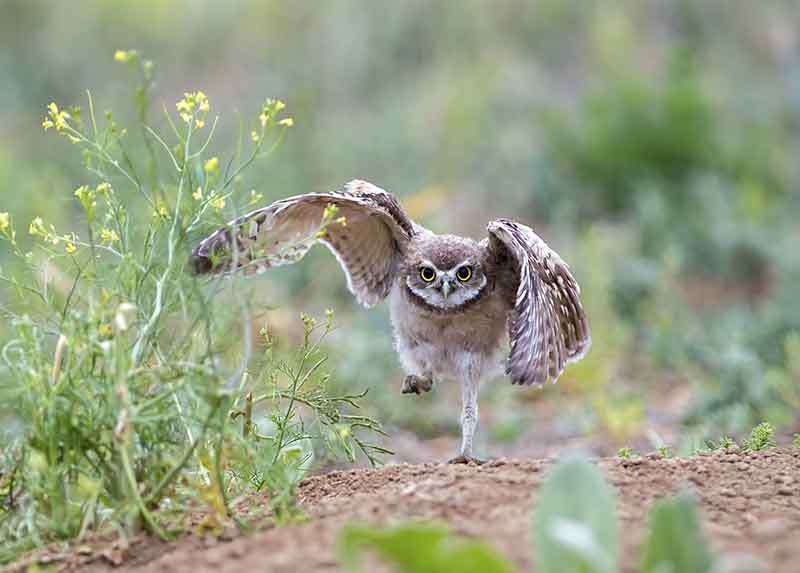
As the name suggests, the burrowing owl nests and roosts in burrows, and although it usually takes over the burrows of prairie dogs, squirrels, or tortoises, it can dig holes itself, using its long legs to excavate the soil. As well as running away, the burrowing owl employs another novel defence to protect itself. When threatened it will go and hide in its burrow and make a rattling and hissing sound similar to that of a rattlesnake, in an example of acoustic Batesian mimicry.
Anything else we should know?
Yes! An owl’s neck is also much longer and skinnier than it looks but the long, thick feathers that cover its neck make it look short and fat. Some owls look as they have no neck at all. An owl can twist its neck to turn its head about 270 degrees in each direction or about ¾ of a circle without moving its shoulders.
It can do his because its head is only connected by one socket pivot. We have two which limits our ability to twist and even if we could we’d tear the linings of our arteries which could clots to form and lead to a stroke.
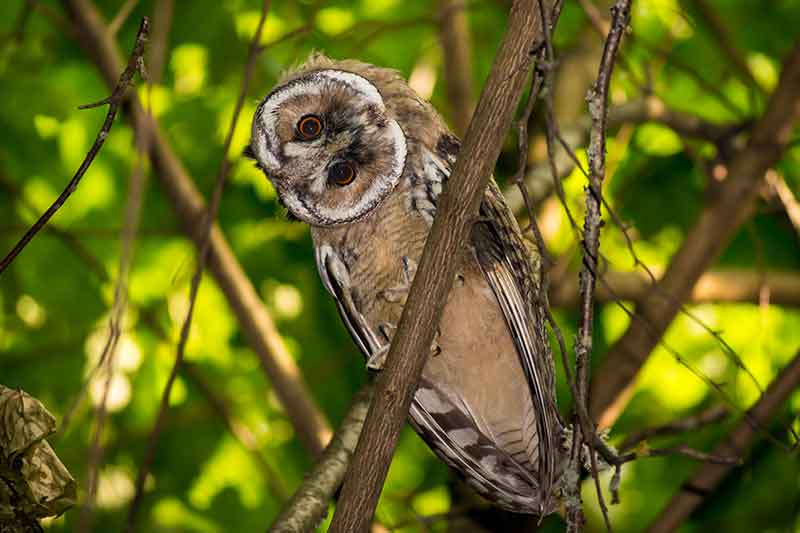
An owl has special large holes in the bones of its neck which hold air and act as cushions to protect its arteries as it turns. Its arteries also enlarge to prevent cutting of the supply of blood to its brain.
And why do owls need to turn their heads to such extremes? It’s because their eyes are tubular, a bit like a telescope, which gives them their remarkable vision. However, they can’t move them about very easily, unlike humans who have spherical eyes, so they have to rotate their heads instead.
One Response
Lovely article, I adore owls and wondered why they have such long legs, you have answered my question!